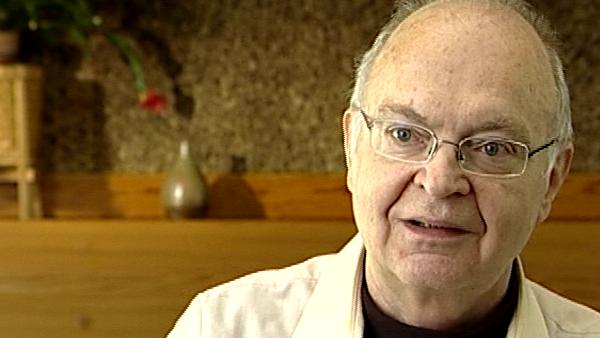NEXT STORY

Learning how to program on the IBM 650
RELATED STORIES

NEXT STORY

Learning how to program on the IBM 650
RELATED STORIES


|
Views | Duration | |
|---|---|---|---|
| 11. University life: my basketball management system | 2123 | 08:09 | |
| 12. University life: the fraternity system | 1748 | 03:36 | |
| 13. Meeting my wife Jill | 1 | 3684 | 04:28 |
| 14. Bible study at university and a time of personal challenge | 1 | 2635 | 03:42 |
| 15. Extra-curricular activities at Case | 1266 | 05:20 | |
| 16. Taking graduate classes at Case | 1380 | 02:58 | |
| 17. Physics, welding, astronomy and mathematics | 1880 | 04:42 | |
| 18. My maths teacher at Case and a difficult problem | 3419 | 06:16 | |
| 19. My interest in graphs and my first experience of a computer | 3769 | 05:13 | |
| 20. How I got interested in programming | 2408 | 03:41 |


I read the manuals that came from IBM, and it had… the manuals had example programs in there, and I… I thought of better ways to… to write those programs. I thought of, you know, well, okay, this program works, but if you did it this way, it would be even better. And… and so that's given me some confidence that maybe I had a talent for… for programming. Now, I… if the manual hadn't had these bad examples in it, I probably would not have gotten interested in… in programming, because I… I wouldn't have this confidence, and I would have been scared and say, oh, I would never think of this. But the fact is, the manuals were pretty stupid, and that's what gave me the confidence that I should think… think a little more about programming, because I might… might be, you know, I might be good at it. So, you know, I started to learn a little bit about computers in my freshman year, then when I pledge at the fraternity, one of the fraternity brothers had a problem… a problem that he needed to solve, and he was… finding the roots of fifth degree equations. And… and I had learned about a program called the Bell Interpretive System that was… that looked like it wouldn't be too hard to… to solve this problem on, and so, since he was, you know, he didn't really want to do it himself, so… so for my fraternity brother I wrote a… I wrote something that would do one of his homework problems for him, and that was… and it seemed to run correctly the first time. I find it hard to believe, now, but it… as far as I know, it did. And… and so he was happy about that, and I, you know, and I got more involved with the people at the Computing Center, where, when I… when they started letting me use this IBM machine during the night.
And… and so between my freshman and sophomore year, I was, I… I had a part time job at the Computing Center, working for them. Really, they allowed us to write software that other people – other students – would be using. The first computer program I… I wrote, it was the following; I had to find the prime factors of a number. So you… you would dial in on the console of the machine; there were rotary switches, and you could set the switch to… to some number, like 100, and then it would punch out 100 is equal to two times two, times five, times five. So we find the prime factors of… of the number you dial on the console switches. I still have a copy of my program for that… that I wrote… and it started out… I had something like 60 or 70 instructions in the… in the program originally, and two weeks later I had the program working correctly, and it had about 130 instructions in it, and I think I had removed more than 200 errors during the time. I mean I… I not only learned about programming, but about making errors. So what can go wrong when you? Well, anyway, I did, I didn't really know that much about programming, at the time, but I learned it a heck of a lot by this exercise of trying to find prime factors of… of a number.
Born in 1938, American computing pioneer Donald Knuth is known for his greatly influential multi-volume work, 'The Art of Computer Programming', his novel 'Surreal Numbers', his invention of TeX and METAFONT electronic publishing tools and his quirky sense of humor.
Title: How I got interested in programming
Listeners: Dikran Karagueuzian
Trained as a journalist, Dikran Karagueuzian is the director of CSLI Publications, publisher of seven books by Donald Knuth. He has known Knuth since the late seventies when Knuth was developing TeX and Metafont, the typesetting and type designing computer programs, respectively.
Tags: IBM Model 650, IBM, Bell Interpretive System, Computing Center, Case Institute of Technology
Duration: 3 minutes, 42 seconds
Date story recorded: April 2006
Date story went live: 24 January 2008